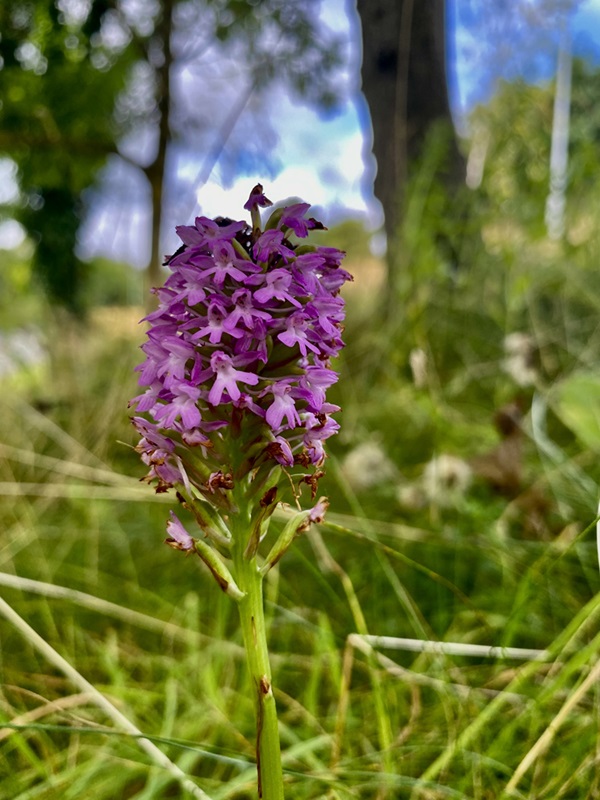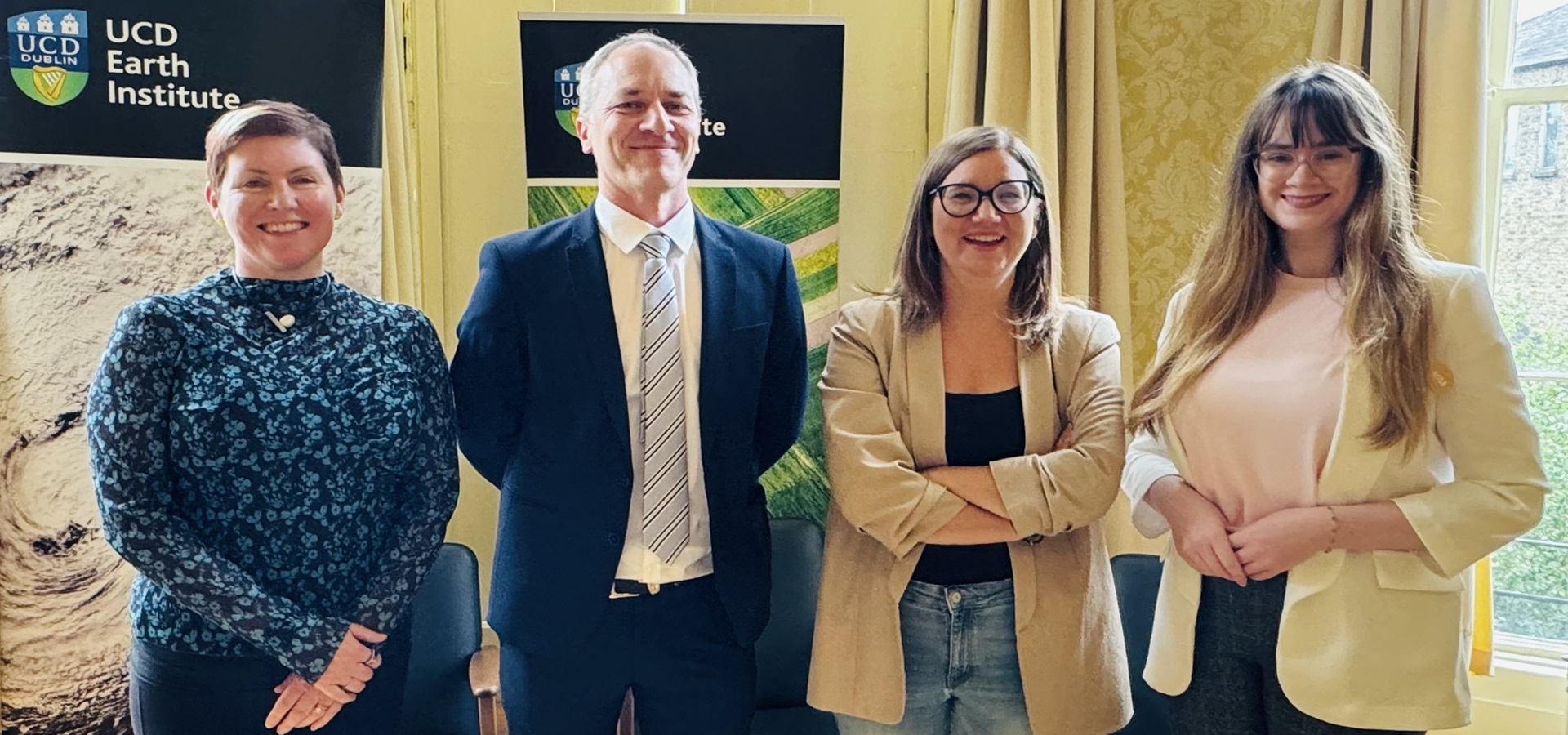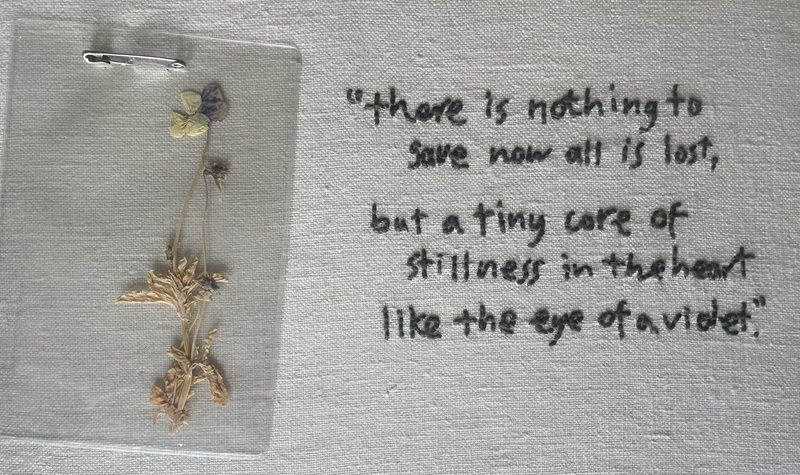Fabled UCD pyramids
By Noeleen Smyth, Aisling Reilly & Dara Stanley
No, its not fiction - UCD has pyramids, all seventeen of them this year in the form of beautiful purple pyramidal orchid flowers. Over the past few year UCD Estates have been leaving sections of the campus grassland unmown during the spring and summer seasons as actions under the UCD Pollinator Plan. These new campus meadows, now allowed to grow freely have been colonised by a suite of native species, one species of native orchid known to readily occupy unmown lawns, banks and road verges especially near the coast is Pyramidal Orchid (Anacamptis pyramidalis). Ireland has 30 native species one of which, the Western Marsh Orchid Dactylorhiza occidentalis, is considered by some as unique to Ireland.

Pyramidal orchids have been known to occur at UCD over the past seven years and in July 2023, twenty-five Pyramidal Orchid were found and monitored, this population has very excitingly recently appeared again in the same place and is flowering again. The flowering period for the species is early June to Mid-August.
The flowers of Pyramidal Orchid have been described as “foxy-smelling” and considered a favourite with moths, including the six-spot burnet moth. The burnet moth is a known pollinator and has been spotted frequenting the UCD pyramidal orchid and Dara Stanley (School of Agriculture and Food Science) and her pollinator team will be sleuthing over the summer recording and monitoring the visitors.
Orchids have lots of underground associations too, as they have a very unusual type of reproduction they need not only pollinating partners but soil and fungal ones too. They must find themselves the fungi of their dreams to unwitting help them reproduce. These fungi belong to the genus Rhizoctonia but too much of an enthusiastic fungus can overwhelm the orchid seed if they are not able to absorb all the generous food offerings the fungus brings. Aisling Reilly (School of Agriculture and Food Science) will be looking into all the fungal partners the UCD orchids are courting.
The population in 2023 consisted of 25 orchids in total, there was one large cluster of 23 orchids and two individuals other close by but separate from each other. This year the numbers were much reduced to 17 orchids. Dr. Noeleen Smyth has been busy marking and measuring them. There are also a number of other choice native Irish species such as Cowslip (Primula veris) and Birds Food Trefoil (Lotus corniculatus) which occupy the bank in early spring and summer, highlighting favourable conditions for native wildflowers. Common urban grassland flowering species such as, Dandelion (Trifolium officnale agg.), Chickweeds (Cerastium spp) were also found with suite of native grasses including Yorkshire fog (Holcus lanatus) and crested dog tail (Cynosurus cristatus). Interestingly the six spotted burnet moth appears to favour the stems of crested dog tail grass for its chrysalis as it changes from caterpillar to moth. The chrysalis cases were also found at the site.
Orchids also suggest low nutrient levels in soil. One of the most threatened habitats in Ireland is our grassland habitat. There are three main EU Annex I grassland habitats types are found in Ireland: Semi-natural dry grasslands on calcareous substrates (Festuco-Brometalia) (6210) and important orchid sites (*6210), Molinia meadows on calcareous, peaty or clayey-silt-laden soils (Molinion caeruleae) (6410), and Lowland hay meadows (Alopecurus pratensis, Sanguisorba officinalis) (6510).
The UCD campus site fits closest to the EU classification of 6210/*6210 habitat, and this is one of the grasslands founds to be under the most severe decline in Ireland with 31% of the surveyed sites of 6210/*6210 reported as lost during the 6 year gap in grassland monitoring due to main pressure of agricultural intensification.
We aim to build up a long term study on the above and below ground action for this population and species at UCD. So in the meantime if you want to see the UCD pyramids take a trip out to the bank behind the car park at the School of Agriculture and Food Science.
Further reading
Arditti, J. 1992. Fundamentals of orchid biology. John Wiley, New York ,New York, USA.
Devlin, Z. (2021). The wildflowers of Ireland. A field guide. 2nd Edition. The Collins Press, p226.
Irish Orchid Society: https://www.irishorchidsociety.org/
Martin, J.R., O’Neill, F.H. & Daly, O.H. (2018) The monitoring and assessment of three EU Habitats Directive Annex I grassland habitats. Irish Wildlife Manuals, No. 102. National Parks and Wildlife Service, Department of Culture, Heritage and the Gaeltacht, Ireland.
Sayers, B. * Sex, S. (2013). Ireland’s wild orchids: a field guide. Collins Press. ISBN 10: 1848891695ISBN 13: 9781848891692
Stace, C. (2019). New Flora of the British Isles. 4th Edition. C&M Floristics.
Vallius, E., Buchsbaum, U. & Nazarov, V. 2013. Pollination activity of Zygaena filipendulae (LINNAEUS, 1758) (Lepidoptera: Zygaenidae) in Anacamptis pyramidalis orchid on the North Bull Island (Ireland) Entomofauna Band 34, Heft 27: 357-368 ISSN 0250-4413.

